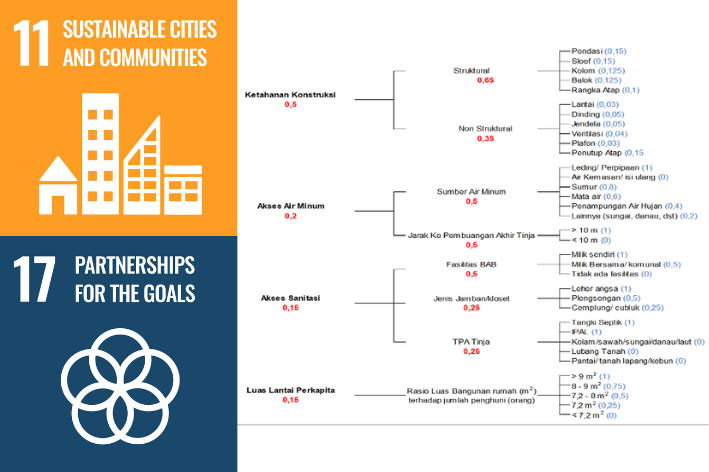Main Article Content
Abstract
Rapid population growth in DKI Jakarta has led to increased territorial density, resulting in a growing number of slums and a housing gap in the availability of decent housing. One of the main challenges in urban planning is the unavailability of accurate and up-to-date data on Unfit-for-Habitation Houses (RTLH), which is still based on sampling methods. Therefore, the primary objective of this community service activity is to develop an efficient data update framework, enabling the Department of Public Housing and Settlement Areas (DPRKP) to update data in real-time without the need for extensive re-surveys. The implementation method involved outreach to the Sub-Department of Public Housing and Settlement Areas (PRKP) across various administrative regions of Jakarta, followed by question-and-answer sessions and discussions. The results indicate that the developed data update framework can enhance the accuracy and efficiency of RTLH information management, thereby supporting more effective data-driven decision-making for the local government.
Keywords
Article Details

This work is licensed under a Creative Commons Attribution-NonCommercial 4.0 International License.
References
- Adianto, J., & Gabe, R. T. (2021). Determinants of vacant subsidized house in Greater Metropolitan Jakarta Area, Indonesia. Journal of Housing and the Built Environment, 36(4), 1813–1830. https://doi.org/10.1007/s10901-021-09828-x
- Alawadhi, S., & Scholl, H. J. (2013). Aspirations and realizations: The smart city of Seattle. Proceedings of the 2013 46th Hawaii International Conference on System Sciences, 1695–1703. https://doi.org/10.1109/HICSS.2013.102
- Barresi, A. (2023). Urban Digital Twin and urban planning for sustainable cities. TECHNE - Journal of Technology for Architecture and Environment, 25, 78–83. https://doi.org/10.36253/techne-13568
- Batty, M. (2018). Digital twins. Environment and Planning B: Urban Analytics and City Science, 45(5), 817–820. https://doi.org/10.1177/2399808318796416
- Belete, Y. S. (2017). Urbanization and Its Impact on Land Use Change in Major Cities in Ethiopia. Land Use Policy, 63, 418–426.
- Burhanuddin, Saptari, M. A., & Fajri, R. (2024). Analisis Model Dalam Melihat Kelayakan Bangunan Rumah Dengan Model Keputusan Weight Product. SISFO: Jurnal Ilmiah Sistem Informasi, 8(2), 96–101.
- Damanhuri, D. S. (2024). A geospatial assessment of the resilience of municipal water supply schemes using an indicator-based framework. Discover Water, 4(1), 1–15.
- Howard, G., Nijhawan, A., Flint, A., Baidya, M., Pregnolato, M., Ghimire, A., Poudel, M., Lo, E., Sharma, S., Mengustu, B., Ayele, D. M., Geremew, A., & Wondim, T. (2021). The How Tough is WASH framework for assessing the climate resilience of water and sanitation. Npj Clean Water, 4(1). https://doi.org/10.1038/s41545-021-00130-5
- Johannessen, Å., Rosemarin, A., Thomalla, F., Swartling, Å. G., Stenström, T. A., & Vulturius, G. (2014). Strategies for building resilience to hazards in water, sanitation and hygiene (WASH) systems: The role of public private partnerships. International Journal of Disaster Risk Reduction, 10, 102–115. https://doi.org/10.1016/j.ijdrr.2014.07.002
- Karim, M. Al, Utomo, G. J., & Fauziah, B. (2019). Kualitas hidup dan pertumbuhan ekonomi, studi kasus DKI Jakarta dan daerah penyangganya. Jurnal Pembangunan Wilayah Dan Kota, 15(3), 227–247. https://doi.org/10.14710/pwk.v15i3.22287
- McGranahan, G., & Satterthwaite, D. (2014). Urbanisation: Concepts and trends. In Environment and Urbanization.
- Mérő, B., Borsos, A., Hosszú, Z., Oláh, Z., & Vágó, N. (2023). A high-resolution, data-driven agent-based model of the housing market. Journal of Economic Dynamics and Control, 155, 105378. https://doi.org/10.1016/j.jedc.2023.104738
- Okoro, C., Umeokafor, & Nnedinma. (2023). A review of technology application and benefits in comprehensive facilities management for housing quality assurance. International Conference on Construction in the 21st Century (CITC-13), 251–268.
- Rolfe, S., Garnham, L., Godwin, J., Anderson, I., Seaman, P., & Donaldson, C. (2020). Housing as a social determinant of health and wellbeing: Developing an empirically-informed realist theoretical framework. BMC Public Health, 20(1), 113278. https://doi.org/10.1186/s12889-020-09224-0
- Sahrin, L. A. (2022). Inovasi Sistem Informasi Pendataan Rumah Tidak Layak Huni (SIGAP-RTLH). Universitas Negeri Surabaya.
- Sejati, W., Fadhilah, A., Sediyono, A., & Prasetyo, R. F. (2022). Surveyor training for housing backlog data collection using location intelligence technology in Krendang Village, West Jakarta. Community Empowerment, 7(10). https://doi.org/10.31603/ce.8042
- Sejati, W., Kuswanda, G. F., Wijayanti, Y., Prasetyo, R. F., Pusoko, A. N. B. S., & Wulandari, S. (2024). Surveyor and dasawisma training in housing database collection in Kampung Rawa Village. Community Empowerment, 9(3). https://doi.org/10.31603/ce.11150
- Selfianti, & Ikhsan, M. (2025). Kinerja Dinas Perumahan Rakyat dan Kawasan Permukiman dalam Pelaksanaan Program Bantuan Rumah Tidak Layak Huni di Kota Dumai. Jurnal Pendidikan Tambusai, 9(1), 560–566.
- Tong, X., Lee, L., & Kim, M. J. (2021). Smart management services for high-rise apartments in Beijing, China. Journal of Asian Architecture and Building Engineering, 21(1), 1–9. https://doi.org/10.1080/13467581.2021.1964974
- Weston, S. L., Nijhawan, A., Reddy, O., Kulabako, R., McCarthy, J., Kayaga, S., & Howard, G. (2024). Improving access to urban piped drinking water services in Africa. Water Supply, 24(12), 4059–4078. https://doi.org/10.2166/ws.2024.251
- Wicaksono, R. S., Brata, A. H., & Ananta, M. T. (2023). Sistem pemetaan dan pelaporan rumah tidak layak huni berbasis web (studi kasus: Dinas Perkim Kabupaten Magetan). Jurnal Pengembangan Teknologi Informasi Dan Ilmu Komputer, 7(2), 613–622.
- Yahya, F., Prabawa, S. E., Mahardianti, M. A., & Alina, A. N. (2020). Pemetaan Kawasan Wilayah Permukiman Rumah Tidak Layak Huni Di Perdesaan (Studi Kasus: Kecamatan Palengaan Dan Kecamatan Batumarmar, Kabupaten Pamekasan). Jurnal Elipsoida, 3(2), 206–217. https://doi.org/10.14710/elipsoida.2020.9205

